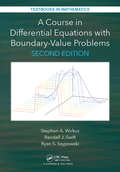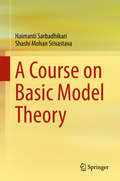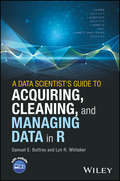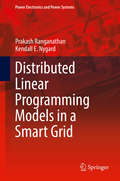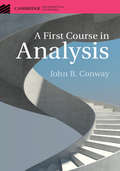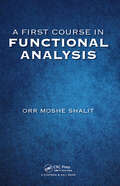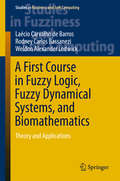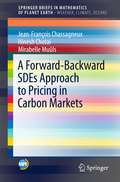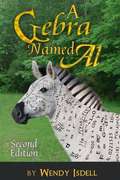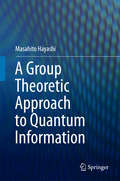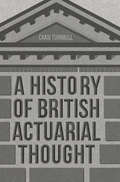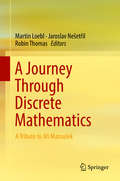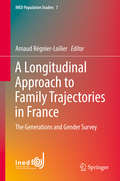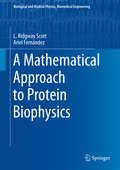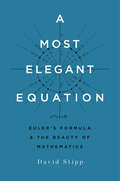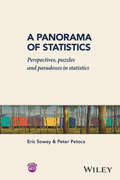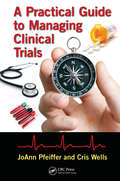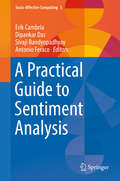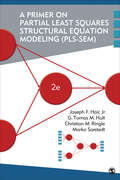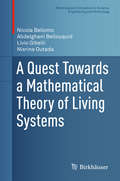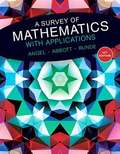- Table View
- List View
A Course in Differential Equations with Boundary Value Problems (Textbooks in Mathematics)
by Stephen A. Wirkus Randall J. Swift Ryan SzypowskiA Course in Differential Equations with Boundary Value Problems, 2nd Edition adds additional content to the author’s successful A Course on Ordinary Differential Equations, 2nd Edition. This text addresses the need when the course is expanded. The focus of the text is on applications and methods of solution, both analytical and numerical, with emphasis on methods used in the typical engineering, physics, or mathematics student’s field of study. The text provides sufficient problems so that even the pure math major will be sufficiently challenged. The authors offer a very flexible text to meet a variety of approaches, including a traditional course on the topic. The text can be used in courses when partial differential equations replaces Laplace transforms. There is sufficient linear algebra in the text so that it can be used for a course that combines differential equations and linear algebra. Most significantly, computer labs are given in MATLAB®, Mathematica®, and Maple™. The book may be used for a course to introduce and equip the student with a knowledge of the given software. Sample course outlines are included. Features MATLAB®, Mathematica®, and Maple™ are incorporated at the end of each chapter. All three software packages have parallel code and exercises; There are numerous problems of varying difficulty for both the applied and pure math major, as well as problems for engineering, physical science and other students. An appendix that gives the reader a "crash course" in the three software packages. Chapter reviews at the end of each chapter to help the students review Projects at the end of each chapter that go into detail about certain topics and introduce new topics that the students are now ready to see Answers to most of the odd problems in the back of the book
A Course on Basic Model Theory
by Shashi Mohan Srivastava Haimanti SarbadhikariThis self-contained book is an exposition of the fundamental ideas of model theory. It presents the necessary background from logic, set theory and other topics of mathematics. Only some degree of mathematical maturity and willingness to assimilate ideas from diverse areas are required. The book can be used for both teaching and self-study, ideally over two semesters. It is primarily aimed at graduate students in mathematical logic who want to specialise in model theory. However, the first two chapters constitute the first introduction to the subject and can be covered in one-semester course to senior undergraduate students in mathematical logic. The book is also suitable for researchers who wish to use model theory in their work.
A Data Scientist's Guide to Acquiring, Cleaning, and Managing Data in R
by Samuel E. Buttrey Lyn R. WhitakerThe only how-to guide offering a unified, systemic approach to acquiring, cleaning, and managing data in R Every experienced practitioner knows that preparing data for modeling is a painstaking, time-consuming process. Adding to the difficulty is that most modelers learn the steps involved in cleaning and managing data piecemeal, often on the fly, or they develop their own ad hoc methods. This book helps simplify their task by providing a unified, systematic approach to acquiring, modeling, manipulating, cleaning, and maintaining data in R. Starting with the very basics, data scientists Samuel E. Buttrey and Lyn R. Whitaker walk readers through the entire process. From what data looks like and what it should look like, they progress through all the steps involved in getting data ready for modeling. They describe best practices for acquiring data from numerous sources; explore key issues in data handling, including text/regular expressions, big data, parallel processing, merging, matching, and checking for duplicates; and outline highly efficient and reliable techniques for documenting data and recordkeeping, including audit trails, getting data back out of R, and more. The only single-source guide to R data and its preparation, it describes best practices for acquiring, manipulating, cleaning, and maintaining data Begins with the basics and walks readers through all the steps necessary to get data ready for the modeling process Provides expert guidance on how to document the processes described so that they are reproducible Written by seasoned professionals, it provides both introductory and advanced techniques Features case studies with supporting data and R code, hosted on a companion website A Data Scientist's Guide to Acquiring, Cleaning and Managing Data in R is a valuable working resource/bench manual for practitioners who collect and analyze data, lab scientists and research associates of all levels of experience, and graduate-level data mining students.
A Distributed Linear Programming Models in a Smart Grid (Power Electronics and Power Systems)
by Prakash Ranganathan Kendall E. NygardThis book showcases the strengths of Linear Programming models for Cyber Physical Systems (CPS), such as the Smart Grids. Cyber-Physical Systems (CPS) consist of computational components interconnected by computer networks that monitor and control switched physical entities interconnected by physical infrastructures. A fundamental challenge in the design and analysis of CPS is the lack of understanding in formulating constraints for complex networks. We address this challenge by employing collection of Linear programming solvers that models the constraints of sub-systems and micro grids in a distributed fashion. The book can be treated as a useful resource to adaptively schedule resource transfers between nodes in a smart power grid. In addition, the feasibility conditions and constraints outlined in the book will enable in reaching optimal values that can help maintain the stability of both the computer network and the physical systems. It details the collection of optimization methods that are reliable for electric-utilities to use for resource scheduling, and optimizing their existing systems or sub-systems. The authors answer to key questions on ways to optimally allocate resources during outages, and contingency cases (e. g. , line failures, and/or circuit breaker failures), how to design de-centralized methods for carrying out tasks using decomposition models; and how to quantify un-certainty and make decisions in the event of grid failures.
A First Course in Analysis (Cambridge Mathematical Textbooks)
by John B. ConwayThis rigorous textbook is intended for a year-long analysis or advanced calculus course for advanced undergraduate or beginning graduate students. Starting with detailed, slow-paced proofs that allow students to acquire facility in reading and writing proofs, it clearly and concisely explains the basics of differentiation and integration of functions of one and several variables, and covers the theorems of Green, Gauss, and Stokes. Minimal prerequisites are assumed, and relevant linear algebra topics are reviewed right before they are needed, making the material accessible to students from diverse backgrounds. Abstract topics are preceded by concrete examples to facilitate understanding, for example, before introducing differential forms, the text examines low-dimensional examples. The meaning and importance of results are thoroughly discussed, and numerous exercises of varying difficulty give students ample opportunity to test and improve their knowledge of this difficult yet vital subject.
A First Course in Functional Analysis
by Orr Moshe ShalitWritten as a textbook, A First Course in Functional Analysis is an introduction to basic functional analysis and operator theory, with an emphasis on Hilbert space methods. The aim of this book is to introduce the basic notions of functional analysis and operator theory without requiring the student to have taken a course in measure theory as a prerequisite. It is written and structured the way a course would be designed, with an emphasis on clarity and logical development alongside real applications in analysis. The background required for a student taking this course is minimal; basic linear algebra, calculus up to Riemann integration, and some acquaintance with topological and metric spaces.
A First Course in Fuzzy Logic, Fuzzy Dynamical Systems, and Biomathematics: Theory and Applications (Studies in Fuzziness and Soft Computing #347)
by Laécio Carvalho de Barros Rodney Carlos Bassanezi Weldon Alexander LodwickThis book provides an essential introduction to the field of dynamical models. Starting from classical theories such as set theory and probability, it allows readers to draw near to the fuzzy case. On one hand, the book equips readers with a fundamental understanding of the theoretical underpinnings of fuzzy sets and fuzzy dynamical systems. On the other, it demonstrates how these theories are used to solve modeling problems in biomathematics, and presents existing derivatives and integrals applied to the context of fuzzy functions. Each of the major topics is accompanied by examples, worked-out exercises, and exercises to be completed. Moreover, many applications to real problems are presented. The book has been developed on the basis of the authors' lectures to university students and is accordingly primarily intended as a textbook for both upper-level undergraduates and graduates in applied mathematics, statistics, and engineering. It also offers a valuable resource for practitioners such as mathematical consultants and modelers, and for researchers alike, as it may provide both groups with new ideas and inspirations for projects in the fields of fuzzy logic and biomathematics.
A Forward-Backward SDEs Approach to Pricing in Carbon Markets (Mathematics of Planet Earth)
by Jean-François Chassagneux Hinesh Chotai Mirabelle MuûlsIn Mathematical Finance, the authors consider a mathematical model for the pricing of emissions permits. The model has particular applicability to the European Union Emissions Trading System (EU ETS) but could also be used to consider the modeling of other cap-and-trade schemes. As a response to the risk of Climate Change, carbon markets are currently being implemented in regions worldwide and already represent more than $30 billion. However, scientific, and particularly mathematical, studies of these carbon markets are needed in order to expose their advantages and shortcomings, as well as allow their most efficient implementation. This Brief reviews mathematical properties such as the existence and uniqueness of solutions for the pricing problem, stability of solutions and their behavior. These fit into the theory of fully coupled forward-backward stochastic differential equations (FBSDEs) with irregular coefficients. The authors present a numerical algorithm to compute the solution to these non-standard FBSDEs. They also carry out a case study of the UK energy market. This involves estimating the parameters to be used in the model using historical data and then solving a pricing problem using the aforementioned numerical algorithm. The Brief is of interest to researchers in stochastic processes and their applications, and environmental and energy economics. Most sections are also accessible to practitioners in the energy sector and climate change policy-makers.
A Gebra Named Al (Second Edition)
by Wendy IsdellTrouble with her algebra homework leads Julie through a mysterious portal into the Land of Mathematics where a zebra-like friend and horse-like creatures representing scientific elements help her learn about math and chemistry in order to get home.
A Group Theoretic Approach to Quantum Information
by Masahito HayashiThis book is the first one addressing quantum information from the viewpoint of group symmetry. Quantum systems have a group symmetrical structure. This structure enables to handle systematically quantum information processing. However, there is no other textbook focusing on group symmetry for quantum information although there exist many textbooks for group representation. After the mathematical preparation of quantum information, this book discusses quantum entanglement and its quantification by using group symmetry. Group symmetry drastically simplifies the calculation of several entanglement measures although their calculations are usually very difficult to handle. This book treats optimal information processes including quantum state estimation, quantum state cloning, estimation of group action and quantum channel etc. Usually it is very difficult to derive the optimal quantum information processes without asymptotic setting of these topics. However, group symmetry allows to derive these optimal solutions without assuming the asymptotic setting. Next, this book addresses the quantum error correcting code with the symmetric structure of Weyl-Heisenberg groups. This structure leads to understand the quantum error correcting code systematically. Finally, this book focuses on the quantum universal information protocols by using the group SU(d). This topic can be regarded as a quantum version of the Csiszar-Korner's universal coding theory with the type method. The required mathematical knowledge about group representation is summarized in the companion book, Group Representation for Quantum Theory.
A History of British Actuarial Thought
by Craig TurnbullIn the first book of its kind, Turnbull traces the development and implementation of actuarial ideas, from the conception of Equitable Life in the mid-18th century to the start of the 21st century. This book analyses the historical development of British actuarial thought in each of its three main practice areas of life assurance, pensions and general insurance. It discusses how new actuarial approaches were developed within each practice area, and how these emerging ideas interacted with each other and were often driven by common external factors such as shocks in the economic environment, new intellectual ideas from academia and developments in technology.A broad range of historically important actuarial topics are discussed such as the development of the blueprint for the actuarial management of with-profit business; historical developments in mortality modelling methods; changes in actuarial thinking on investment strategy for life and pensions business; changing perspectives on the objectives and methods for funding Defined Benefit pensions; the application of risk theory in general insurance reserving; the adoption of risk-based reserving and the Guaranteed Annuity Option crisis at the end of the 20th century.This book also provides an historical overview of some of the most important external contributions to actuarial thinking: in particular, the first century or so of modern thinking on probability and statistics, starting in the 1650s with Pascal and Fermat; and the developments in the field of financial economics over the third quarter of the twentieth century. This book identifies where historical actuarial thought heuristically anticipated some of the fundamental ideas of modern finance, and the challenges that the profession wrestled with in reconciling these ideas with traditional actuarial methods. Actuaries have played a profoundly influential role in the management of the United Kingdom’s most important long-term financial institutions over the last two hundred years. This book will be the first to chart the influence of the actuarial profession to modern day. It will prove a valuable resource for actuaries, actuarial trainees and students of actuarial science. It will also be of interest to academics and professionals in related financial fields such as accountants, statisticians, economists and investment managers.
A Journey Through Discrete Mathematics: A Tribute To Ji I Matou Ek
by Jaroslav Nešetřil Martin Loebl Robin ThomasThis collection of high-quality articles in the field of combinatorics, geometry, algebraic topology and theoretical computer science is a tribute to Jiř#65533; Matousek, who passed away prematurely in March 2015. It is a collaborative effort by his colleagues and friends, who have paid particular attention to clarity of exposition - something Jirka would have approved of. The original research articles, surveys and expository articles, written by leading experts in their respective fields, map Jiř#65533; Matousek's numerous areas of mathematical interest.
A Longitudinal Approach to Family Trajectories in France
by Arnaud Régnier-LoilierAdopting a longitudinal approach, this book examines the dynamics of union and family formation in France and its effects on various aspects of life, such as employment, intergenerational transfers, etc. Drawing on data from a survey in which the same respondents were interviewed three times at three-year intervals, the book explores how demographic behaviours are influenced across the life course at individual level and assesses some of their consequences. The contributors give a clear understanding of how family behaviours are constructed and redefined. They track changes in respondents’ lives in order to pinpoint the factors that prevent couples from realizing their fertility intentions, for example, or to identify certain determinants of union formation or dissolution. They also provide a more detailed picture of the changes that shape family behaviours, such as the impact of a birth on the working career or on intergenerational support, and much more. Using longitudinal data from the French version of the Generations and Gender Survey (GGS), this book addresses family and childbearing behaviours dynamically, as processes that interact with each other and with the other components of each individual's life course.
A Mathematical Approach to Protein Biophysics (Biological and Medical Physics, Biomedical Engineering)
by L. Ridgway Scott Ariel FernándezThis book explores quantitative aspects of protein biophysics and attempts to delineate certain rules of molecular behavior that make atomic scale objects behave in a digital way. This book will help readers to understand how certain biological systems involving proteins function as digital information systems despite the fact that underlying processes are analog in nature. The in-depth explanation of proteins from a quantitative point of view and the variety of level of exercises (including physical experiments) at the end of each chapter will appeal to graduate and senior undergraduate students in mathematics, computer science, mechanical engineering, and physics, wanting to learn about the biophysics of proteins. L. Ridgway Scott has been Professor of Computer Science and of Mathematics at the University of Chicago since 1998, and the Louis Block Professor since 2001. He obtained a B. S. degree (Magna Cum Laude) from Tulane University in 1969 and a PhD degree in Mathematics from the Massachusetts Institute of Technology in 1973. Professor Scott has published over 130 papers and three books, extending over biophysics, parallel computing and fundamental computing aspects of structural mechanics, fluid dynamics, nuclear engineering, and computational chemistry. Ariel Fern#65533;ndez (born Ariel Fern#65533;ndez Stigliano) is an Argentinian-American physical chemist and mathematician. He obtained his Ph. D. degree in Chemical Physics from Yale University and held the Karl F. Hasselmann Endowed Chair Professorship in Bioengineering at Rice University. He is currently involved in research and entrepreneurial activities at various consultancy firms. Ariel Fern#65533;ndez authored three books on translational medicine and biophysics, and published 360 papers in professional journals. He holds two patents in the field of biotechnology.
A Most Elegant Equation: Euler's Formula and the Beauty of Mathematics
by David StippAn award-winning science writer introduces us to mathematics using the extraordinary equation that unites five of mathematics' most important numbersBertrand Russell wrote that mathematics can exalt "as surely as poetry." This is especially true of one equation: ei(pi) + 1 = 0, the brainchild of Leonhard Euler, the Mozart of mathematics. More than two centuries after Euler's death, it is still regarded as a conceptual diamond of unsurpassed beauty. Called Euler's identity or God's equation, it includes just five numbers but represents an astonishing revelation of hidden connections. It ties together everything from basic arithmetic to compound interest, the circumference of a circle, trigonometry, calculus, and even infinity. In David Stipp's hands, Euler's identity formula becomes a contemplative stroll through the glories of mathematics. The result is an ode to this magical field.
A Panorama of Statistics: Perspectives, Puzzles and Paradoxes in Statistics
by Peter Petocz Eric SoweyThis book is a stimulating panoramic tour – quite different from a textbook journey – of the world of statistics in both its theory and practice, for teachers, students and practitioners.At each stop on the tour, the authors investigate unusual and quirky aspects of statistics, highlighting historical, biographical and philosophical dimensions of this field of knowledge. Each chapter opens with perspectives on its theme, often from several points of view. Five original and thought-provoking questions follow. These aim at widening readers’ knowledge and deepening their insight. Scattered among the questions are entertaining puzzles to solve and tantalising paradoxes to explain. Readers can compare their own statistical discoveries with the authors’ detailed answers to all the questions. The writing is lively and inviting, the ideas are rewarding, and the material is extensively cross-referenced. A Panorama of Statistics: Leads readers to discover the fascinations of statistics. Is an enjoyable companion to an undergraduate statistics textbook. Is an enriching source of knowledge for statistics teachers and practitioners. Is unique among statistics books today for its memorable content and engaging style. Lending itself equally to reading through and to dipping into, A Panorama of Statistics will surprise teachers, students and practitioners by the variety of ways in which statistics can capture and hold their interest.Reviews:"As befits the authors' statement that 'this is not a textbook', the structure is unusual. There are twenty-five chapters organised in five sections, each beginning with a brief perspective of a theme in statistics and finishing with five questions related to that theme. The answers provided to the questions, in section six, are as discursive and illuminating as the main body of the text. Even if you are pretty sure you know the answer, it is always worth checking what the authors have to say. Chances are that you will learn something every time. The glimpses and insights given into this enormous and far-reaching discipline succeed in being bewitching, entertaining and inviting; coverage was never the aim." "In summary, this splendid book lives up to the four 'p-values' of its title. It is panoramic in the scope of its survey of statistics, it is full of illuminating perspectives, it sets entertaining and challenging puzzles, and it explores fascinating paradoxes. Read it, enjoy it and learn from it."From Neil Sheldon, Teaching Statistics, volume 9, no. 2, May 2017
A Practical Guide to Managing Clinical Trials
by JoAnn Pfeiffer Cris WellsA Practical Guide to Managing Clinical Trials is a basic, comprehensive guide to conducting clinical trials. Designed for individuals working in research site operations, this user-friendly reference guides the reader through each step of the clinical trial process from site selection, to site set-up, subject recruitment, study visits, and to study close-out. Topics include staff roles/responsibilities/training, budget and contract review and management, subject study visits, data and document management, event reporting, research ethics, audits and inspections, consent processes, IRB, FDA regulations, and good clinical practices. Each chapter concludes with a review of key points and knowledge application. <P><P> Unique to this book is "A View from India," a chapter-by-chapter comparison of clinical trial practices in India versus the U.S. Throughout the book and in Chapter 10, readers will glimpse some of the challenges and opportunities in the emerging and growing market of Indian clinical trials.
A Practical Guide to Sentiment Analysis (Socio-Affective Computing #5)
by Erik Cambria Dipankar Das Sivaji Bandyopadhyay Antonio FeracoSentiment analysis research has been started long back and recently it is one of the demanding research topics. Research activities on Sentiment Analysis in natural language texts and other media are gaining ground with full swing. But, till date, no concise set of factors has been yet defined that really affects how writers' sentiment i. e. , broadly human sentiment is expressed, perceived, recognized, processed, and interpreted in natural languages. The existing reported solutions or the available systems are still far from perfect or fail to meet the satisfaction level of the end users. The reasons may be that there are dozens of conceptual rules that govern sentiment and even there are possibly unlimited clues that can convey these concepts from realization to practical implementation. Therefore, the main aim of this book is to provide a feasible research platform to our ambitious researchers towards developing the practical solutions that will be indeed beneficial for our society, business and future researches as well.
A Primer On String Theory
by Volker SchomerusSince its conception in the 1960s, string theory has been hailed as one of the most promising routes we have to unify quantum mechanics and general relativity. This book provides a concise introduction to string theory explaining central concepts, mathematical tools and covering recent developments in physics including compactifications and gauge/string dualities. With string theory being a multidisciplinary field interfacing with high energy physics, mathematics and quantum field theory, this book is ideal for both students with no previous knowledge of the field and scholars from other disciplines who are looking for an introduction to basic concepts.
A Primer for Undergraduate Research: From Groups and Tiles to Frames and Vaccines (Foundations for Undergraduate Research in Mathematics)
by Christopher Lee Aaron Wootton Valerie PetersonThis highly readable book aims to ease the many challenges of starting undergraduate research. It accomplishes this by presenting a diverse series of self-contained, accessible articles which include specific open problems and prepare the reader to tackle them with ample background material and references. Each article also contains a carefully selected bibliography for further reading.The content spans the breadth of mathematics, including many topics that are not normally addressed by the undergraduate curriculum (such as matroid theory, mathematical biology, and operations research), yet have few enough prerequisites that the interested student can start exploring them under the guidance of a faculty member. Whether trying to start an undergraduate thesis, embarking on a summer REU, or preparing for graduate school, this book is appropriate for a variety of students and the faculty who guide them.
A Primer on Partial Least Squares Structural Equation Modeling (PLS-SEM)
by G. Tomas Hult Marko Sarstedt Dr Joe Hair Dr Christian M. RingleA Primer on Partial Least Squares Structural Equation Modeling (PLS-SEM) by Joseph F. Hair, Jr., G. Tomas M. Hult, Christian Ringle, and Marko Sarstedt is a practical guide that provides concise instructions on how to use partial least squares structural equation modeling (PLS-SEM), an evolving statistical technique, to conduct research and obtain solutions. Featuring the latest research, new examples using the SmartPLS software, and expanded discussions throughout, the Second Edition is designed to be easily understood by those with limited statistical and mathematical training who want to pursue research opportunities in new ways.
A Primer on Partial Least Squares Structural Equation Modeling (PLS-SEM)
by G. Tomas Hult Marko Sarstedt Dr Joe Hair Dr Christian M. RingleA Primer on Partial Least Squares Structural Equation Modeling (PLS-SEM) by Joseph F. Hair, Jr., G. Tomas M. Hult, Christian Ringle, and Marko Sarstedt is a practical guide that provides concise instructions on how to use partial least squares structural equation modeling (PLS-SEM), an evolving statistical technique, to conduct research and obtain solutions. Featuring the latest research, new examples using the SmartPLS software, and expanded discussions throughout, the Second Edition is designed to be easily understood by those with limited statistical and mathematical training who want to pursue research opportunities in new ways.
A Quest Towards a Mathematical Theory of Living Systems (Modeling and Simulation in Science, Engineering and Technology)
by Nicola Bellomo Abdelghani Bellouquid Livio Gibelli Nisrine OutadaThis monograph aims to lay the groundwork for the design of a unified mathematical approach to the modeling and analysis of large, complex systems composed of interacting living things. Drawing on twenty years of research in various scientific fields, it explores how mathematical kinetic theory and evolutionary game theory can be used to understand the complex interplay between mathematical sciences and the dynamics of living systems. The authors hope this will contribute to the development of new tools and strategies, if not a new mathematical theory. The first chapter discusses the main features of living systems and outlines a strategy for their modeling. The following chapters then explore some of the methods needed to potentially achieve this in practice. Chapter Two provides a brief introduction to the mathematical kinetic theory of classical particles, with special emphasis on the Boltzmann equation; the Enskog equation, mean field models, and Monte Carlo methods are also briefly covered. Chapter Three uses concepts from evolutionary game theory to derive mathematical structures that are able to capture the complexity features of interactions within living systems. The book then shifts to exploring the relevant applications of these methods that can potentially be used to derive specific, usable models. The modeling of social systems in various contexts is the subject of Chapter Five, and an overview of modeling crowd dynamics is given in Chapter Six, demonstrating how this approach can be used to model the dynamics of multicellular systems. The final chapter considers some additional applications before presenting an overview of open problems. The authors then offer their own speculations on the conceptual paths that may lead to a mathematical theory of living systems hoping to motivate future research activity in the field. A truly unique contribution to the existing literature, A Quest Toward a Mathematical Theory of Living Systems is an important book that will no doubt have a significant influence on the future directions of the field. It will be of interest to mathematical biologists, systems biologists, biophysicists, and other researchers working on understanding the complexities of living systems.
A Second Course in Linear Algebra (Cambridge Mathematical Textbooks)
by Roger A. Horn Stephan Ramon GarciaLinear algebra is a fundamental tool in many fields, including mathematics and statistics, computer science, economics, and the physical and biological sciences. This undergraduate textbook offers a complete second course in linear algebra, tailored to help students transition from basic theory to advanced topics and applications. Concise chapters promote a focused progression through essential ideas, and contain many examples and illustrative graphics. In addition, each chapter contains a bullet list summarising important concepts, and the book includes over 600 exercises to aid the reader's understanding. Topics are derived and discussed in detail, including the singular value decomposition, the Jordan canonical form, the spectral theorem, the QR factorization, normal matrices, Hermitian matrices (of interest to physics students), and positive definite matrices (of interest to statistics students).
A Survey Of Mathematics With Applications
by Allen R. Angel Christine D. Abbott Dennis C. RundeMathematics is an exciting, living study. Its applications shape the world around you and influence your everyday life. We hope that as you read this book you will realize just how important mathematics is and gain an appreciation of both its usefulness and its beauty. We also hope to teach you some practical mathematics that you can use every day and that will prepare you for further mathematics courses. The primary purpose of this text is to provide material that you can read, under¬stand, and enjoy. To this end, we have used straightforward language and tried to re¬late the mathematical concepts to everyday experiences. We have also provided many detailed examples for you to follow.
